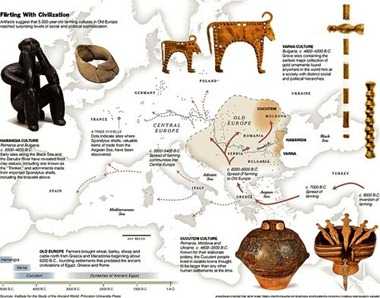The 'forgotten civilisations' of Neolithic Europe and their ties to ancient Greece are the subject of a temporary exhibition that opens its doors to the public on Thursday at the Cycladic Art Museum in central Athens.
 Entitled "The Lost World of Old Europe: The Danube Valley, 5000-3500 B.C." the exhibition will be inaugurated by Deputy Foreign Minister Spyros Kouvelis on Wednesday evening.
Entitled "The Lost World of Old Europe: The Danube Valley, 5000-3500 B.C." the exhibition will be inaugurated by Deputy Foreign Minister Spyros Kouvelis on Wednesday evening.
Organised by the Institute for the Study of the Ancient World at New York University in collaboration with the National History Museum of Romania in Bucharest and with the participation of the Varna Regional Museum of History in Bulgaria and the National Museum of Archaeology and History of Moldova in Chisinau, the exhibition brings together more than 200 Neolithic artifacts owned by 22 museums in Romania, Bulgaria and Moldova. (ANA-MPA)
Parallel with the main exhibition, the Museum of Cycladic Art and the ministry of culture and tourism have organised a second exhibition on "The relations between Neolithic Greece and the Balkans" presented alongside the first for comparative reasons. This includes 90 exhibits from Greek Neolithic sites of the same period and explores the similarities and differences between Greece and the Balkans during the 5th and 4th millenniums BC.
The organisers explore a little-known period of human history, noting that the area of southeastern Europe had seen the growth of highly sophisticated societies with advanced technology that disappeared abruptly and mysteriously at around 4000 B.C. for reasons as yet unknown.
Among the most impressive of the exhibits are remarkably modern-looking figurines with human form, some excellent quality, brightly coloured ceramic vases, various metal objects and the world's largest single store of Neolithic gold objects found in an ancient cemetery in Varna.
Goulandris Foundation president Sandra Marinopoulou stressed in a press conference on Tuesday that visitors to the exhibition will gain a fascinating insight into the history of SE Europe 7,000 years ago.
According to Cycladic Art Museum Director Nikolaos Stambolidis, Greece's closest neighbours were "participants" in the cultural product arising from this part of the world from the Neolithic period and onward.
"These two exhibitions come to shed light on the rich past of a region around the Danube and the northwestern coast of the Black Sea during the 3rd and 4th pre-Christian millennia. (ANA-MPA) This exhibition presents a forgotten part [of history] that we must remember without borders but only on geographic terms," he noted.
According to Dr. Dragomir Nicolae Popovici of the National History Museum of Romania, it also marked the first time that such an exhibition "that is a major chapter of European history" was organised, while Dr. Aleksander Minchev of the Varna Archaeological Museum Ancient Art department stressed that it was a chance to view "the birth of European culture". (ANA-MPA)
The parallel exhibitions are taking place under the aegis of the Greek foreign ministry as part of its presidency of the Black Sea Economic Cooperation (BSEC) organisation and will run until January 10, 2011.
Source: ANA-MPA [October 06, 2010]